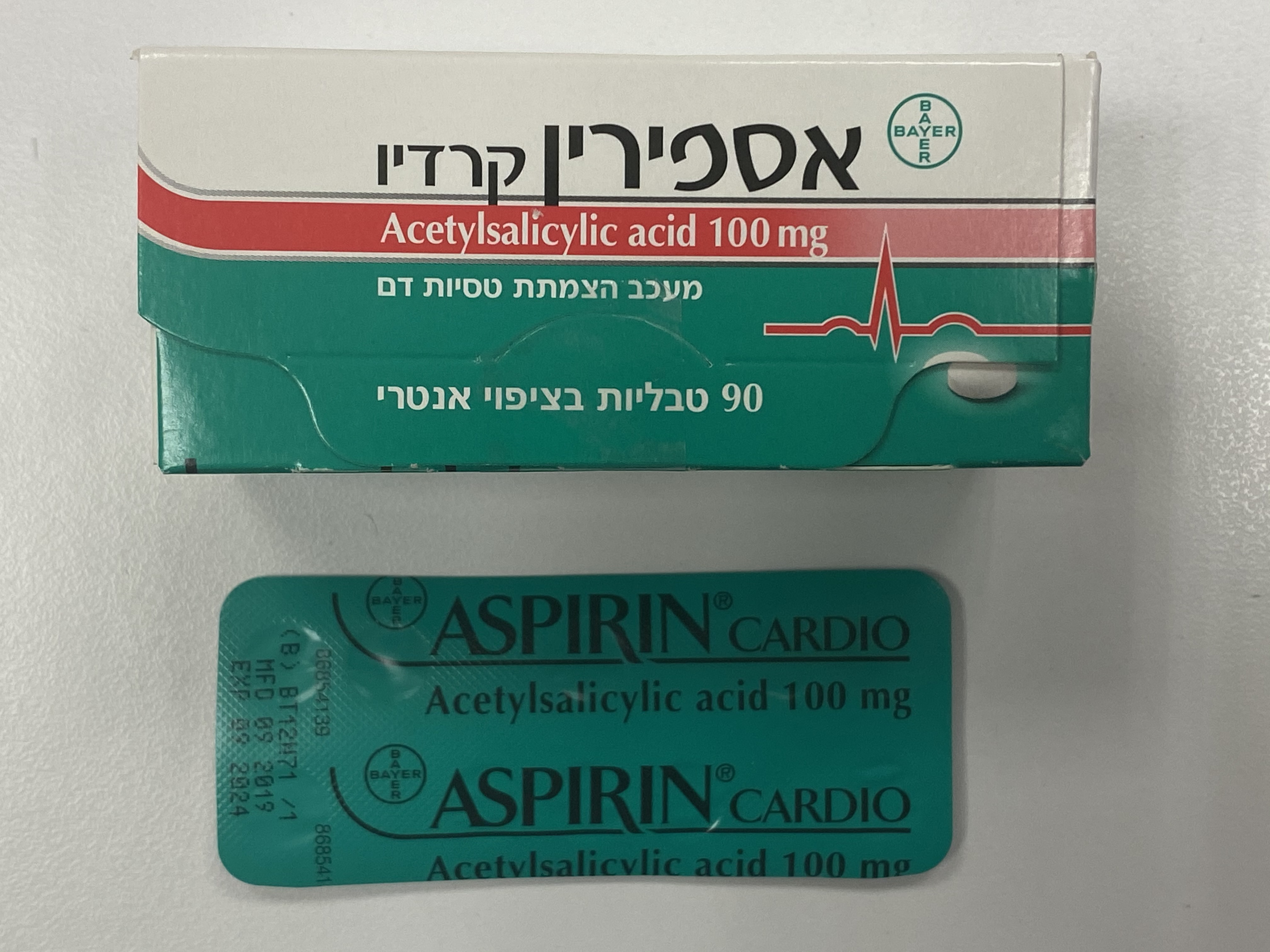Quest for the right Drug

אספירין קרדיו ASPIRIN CARDIO (ACETYLSALICYLIC ACID)
תרופה במרשם
תרופה בסל
נרקוטיקה
ציטוטוקסיקה
צורת מתן:
פומי : PER OS
צורת מינון:
טבליות עם ציפוי אנטרי : TABLETS ENTERIC COATED
עלון לרופא
מינוניםPosology התוויות
Indications תופעות לוואי
Adverse reactions התוויות נגד
Contraindications אינטראקציות
Interactions מינון יתר
Overdose הריון/הנקה
Pregnancy & Lactation אוכלוסיות מיוחדות
Special populations תכונות פרמקולוגיות
Pharmacological properties מידע רוקחי
Pharmaceutical particulars אזהרת שימוש
Special Warning עלון לרופא
Physicians Leaflet
Pharmacological properties : תכונות פרמקולוגיות
Pharmacodynamic Properties
5.1 Pharmacodynamic properties Pharmacotherapeutic group: Antithrombotic agents, Platelet aggregation inhibitors, acetylsalicylic acid. ATC code: B01AC06 Acetylsalicylic acid has an irreversible platelet aggregation-inhibiting action. This antiplatelet effect is achieved by acetylation of cyclooxygenase, irreversibly inhibiting the formation of thromboxane A2 (a prostaglandin with a platelet aggregation-promoting and vasoconstrictive action) in the platelets. The effect is long-term and usually persists for the entire eight-day lifespan of a platelet. Paradoxically, acetylsalicylic acid also inhibits the formation of prostacyclin (a prostaglandin with platelet aggregation-inhibiting but vasodilating effects) in the endothelial cells of the vascular walls. This effect is transient. Once the acetylsalicylic acid has been washed out of the blood, the nucleated endothelial cells resume their production of prostacyclin. As a consequence, once daily administration of low-dosage (< 300 mg / day) acetylsalicylic acid causes inhibition of thromboxane A2 in the platelets without markedly impairing prostacyclin formation. Acetylsalicylic acid also belongs to the class of acid-forming nonsteroidal anti- inflammatory drugs with analgesic, antipyretic and anti-inflammatory properties. Its mechanism of action is based on irreversible inhibition of cyclooxygenase enzymes involved in prostaglandin synthesis. Acetylsalicylic acid is used at higher oral doses to treat mild to moderate pain, elevated temperature and acute and chronic inflammatory diseases (e.g. rheumatoid arthritis). Experimental data suggest that ibuprofen may inhibit the effect of low dose acetylsalicylic acid on platelet aggregation when they are administered concomitantly. In one study, when a single dose of ibuprofen 400 mg was taken 8 h before or 30 min after immediate release aspirin dosing (81 mg), a decreased effect of ASA on the formation of thromboxane or platelet aggregation occurred. However, the limitations of these data and the uncertainties regarding extrapolation of ex vivo data to a clinical setting imply that no firm conclusion can be made for regular ibuprofen use, and no clinically relevant effect is considered to be likely for occasional ibuprofen use.
Pharmacokinetic Properties
5.2 Pharmacokinetic properties Acetylsalicylic acid is converted before, during and after absorption into its main metabolite salicylic acid. The metabolites are excreted primarily via the renal route. In addition to salicylic acid, the main metabolites of acetylsalicylic acid include the glycine conjugate of salicylic acid (salicyluric acid), the ether and ester glucuronides of salicylic acid (salicyl phenolic glucuronide and salicyl acetyl glucuronide) and gentisic acid produced by oxidation of salicylic acid and its glycine conjugate. Depending on the formulation, absorption of acetylsalicylic acid following oral administration is rapid and complete. The residual acetyl portion of acetylsalicylic acid undergoes partial hydrolytic cleavage during its passage through the mucous membranes of the gastrointestinal tract. Peak plasma concentrations are attained after 10 -20 minutes (acetylsalicylic acid) and 0.3 -2 hours (total salicylate). The elimination kinetics of salicylic acid are dependent to a great extent on the dose, as the capacity for metabolism of salicylic acid is limited (elimination half-life fluctuates between 2 and 30 h). The elimination half-life of acetylsalicylic acid is only a few minutes; the elimination half- life of salicylic acid is 2 h after consumption of a dose of 0.5 g acetylsalicylic acid and 4 h after administration of 1 g; following consumption of a single dose of 5 g, the elimination half-life is extended to 20 h. Protein binding in human plasma is dependent on the concentration; values ranging from 49 % to over 70 % (acetylsalicylic acid) and 66 % to 98 % (salicylic acid) have been reported. Salicylic acid has been detected in cerebrospinal fluid and synovial fluid after consumption of acetylsalicylic acid. Salicylic acid crosses the placental barrier and passes into breast milk.

שימוש לפי פנקס קופ''ח כללית 1994
Antiplatelet aggregation agent
תאריך הכללה מקורי בסל
01/01/1995
הגבלות
תרופה שאושרה לשימוש כללי בקופ'ח
מידע נוסף
עלון מידע לצרכן
23.09.21 - עלון לצרכן אנגלית 23.09.21 - עלון לצרכן עברית 23.09.21 - עלון לצרכן ערבית 14.04.24 - עלון לצרכן עברית 23.07.24 - עלון לצרכן אנגלית 23.07.24 - עלון לצרכן עברית 23.07.24 - עלון לצרכן ערבית 24.07.18 - החמרה לעלון 03.08.20 - החמרה לעלון 18.07.21 - החמרה לעלון 20.03.14 - החמרה לעלון 08.05.24 - החמרה לעלוןלתרופה במאגר משרד הבריאות
אספירין קרדיו